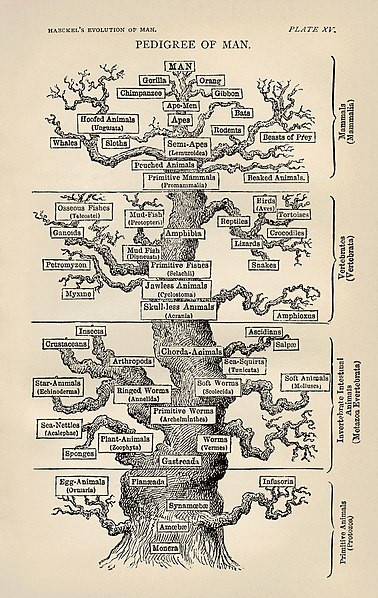
The evolutionary “tree of life” is a well-known metaphor for the broad scope and branching pattern of evolution over time. This metaphor was first developed by Charles Darwin in On the Origin of Species, as a way to help shape his ideas about evolution by natural selection.
Darwin used several of different metaphors in Origin, but the tree of life is key in that it presents his central organizing vision of shared descent, the idea that all species are related and ultimately evolved from a common ancestor in the distant past. From a single starting point in this image, genetic changes in different populations send species down different evolutionary paths. Some of these “branches” survive, and split in turn to end off new branches. Other branches wither, and species become extinct. The species we see today are represented on the tree by new budding twigs, and those species that have become extinct are represented by the woody branches.
The idea that all species are related by common descent from a single ancestor is quite a profound difference between Darwin’s ideas about evolution and other ideas about evolution that had come before. This is probably the aspect of his theory that has been resisted the most by the general public. If all life is related by common descent, what does this imply about humanity and our place in the world? In Darwin’s view of nature, humans are an integral part of the natural environment, rather than in a separate, special position. Because Western religious traditions emphasize a separation between humans and the rest of nature, Darwin’s ideas were (and have remained) controversial.

In fact, Darwin’s metaphor of the tree of life was so influential in his lifetime that caricatures mocking his idea of common descent generally feature a tree somewhere in the image (while the other common motif is Darwin himself pictured as an ape-man).
What type of tree do you picture when you think about the tree of life?
While the tree of life does a good job of illustrating common descent, this metaphor, like all metaphors, has a few limitations. For one, the tree in the metaphor is often depicted as a temperate tree like an oak, with a thick central trunk. This thick, woody trunk doesn’t map well to what we know about early evolution- for example, we now know that there were probably many instances of gene transfer among different groups of organisms early in the history of life. Some biologists have suggested replacing the traditional oak tree with an image of a mangrove, with many interconnected branches and roots near its base, in recognition of this early complexity in the history of life.

While modern research gives insights into the evolutionary history of life that Darwin could only have dreamed of, his broad metaphor of a tree still seems to be going strong. Regardless of its ultimate shape, the tree of life seems poised to remain with us for a long time to come. However, this does not mean that there aren’t alternative ways to picture evolution. Could an alternative metaphor to the tree of life help us make mental connections about evolution in different ways? This is a question I hope to answer in my own research.
References:
Gruber, Howard E. “Darwin’s ‘Tree of Nature’ and Other Images of Wide Scope.” in Howard E. Gruber and Katja Bodeker (eds.) Creativity, Psychology and the History of Science, pp 241-257. New York: Springer, 2005.
Gruber, Howard E. “Ensembles of Metaphors in Creative Scientific Thinking.” in Howard E. Gruber and Katja Bodeker (eds.) Creativity, Psychology and the History of Science, pp 259-270. New York: Springer, 2005.
Larson, Barbara, and Fae Brauer. The Art of Evolution: Darwin, Darwinisms, and Visual Culture. Hanover, NH: Dartmouth CP, 2009.
Stevens, Peter F. “Pattern and Process: Phylogenetic Reconstruction in Botany.” in Henry M. Hoenigswald and Linda F. Weiner (eds.) Biological Metaphor and Cladistic Classification. pp. 155-179. Philadelphia: U of Pennsylvania, 1987.
One reply on “Darwin’s tree of life as a metaphor for evolution”
[…] image of a branching tree. I’ve discussed some of the limitations of the tree metaphor in a previous post; essentially, it’s difficult for us to discard the misleading aspects of the tree metaphor […]